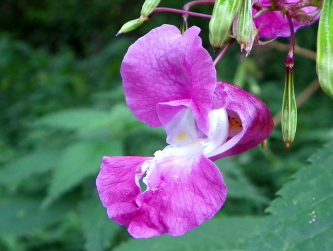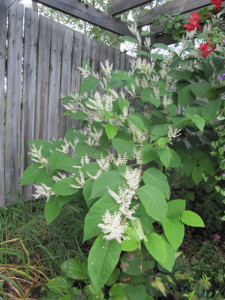Invasive Neophytes
Development of the Alpine Landscape in Film
13.10.2015
By Katharina Bochter and Stefanie Schlosser, Alumni Environmental Studies Certificate Program Students
Update on their project: It was featured on Bavarian Television on 24 July 2016 and can be viewed online (the feature is covered in the first 8 minutes of the video).

Japanese knotweed. Photograph: Leonora Enking, via Flickr.
Imagine 10,000 years ago. The entire area north of the Alps, the Alpine upland, was a vast desert. The glaciers of the last ice age were just melting, and there was nothing but grass and moss. Nothing but tundra. As it became warmer, new plant species, especially from the Mediterranean, started to invade the area. It didn’t take long for the ground to become protected by mixed forest. Since then, the soil underneath it has been developing. Mankind came and began to change the landscape that they had entered. In the medieval period people cut down many of the forests, especially for salt production and to create new farmland. Our landscape began to change dramatically.
As students of the RCC’s Environmental Studies Certificate Program we wanted to show part of the further development of this landscape in a film, which we made for our final project. In it, we tell the story of invasive neophytes in our home region. This region is at the foothills of the Bavarian Alps, a district called Berchtesgadener Land, southeast Bavaria. A couple of years ago we had both noticed that invasive plant species had been invading our childhood playgrounds. In a local riparian forest of the Saalach, near Bad Reichenhall, policeman’s helmet (Impatiens glandulifera) and Japanese knotweed (Fallopia japonica) had begun to change the landscape as we knew it. In 2013, Stefanie started a project to combat these plants as part of her Zulassungsarbeit (term paper) for the first state exam in geography. We can already see the first results!
Our film’s story is structured according to three questions. Firstly, we look for a proper definition of “invasive neophytes.” We travelled to Salzburg to interview Elisabeth Ortner from the natural history museum, “Haus der Natur.” As a biologist, she is responsible for nature reservation areas in the Flachgau region, cooperating with governmental institutions and local people. Elisabeth told us that the story of invasive neophytes started in 1492, when Columbus discovered the Americas. After this discovery, new plant species, such as the potato and zucchini, were consciously introduced to Middle Europe.
Trade with other areas around the globe also increased: this is why also plants and, of course, animals were transported both deliberately and unintentionally around the world. Botanical gardens were founded to collect and showcase all of the world’s plant species in just one spot. People started to have private gardens, too. Suddenly, many people wanted to cultivate exotic plant species. This process started around 1800, when policeman’s helmet was introduced from the Himalayas, and Japanese knotweed from East Asia. These plants were first brought to botanical gardens in England, but later became popular garden plants. People in our home region also cultivated them.
The second question follows from asking why invasive species are a problem. The two species that we have focused on—Policeman’s helmet and Japanese knotweed—are very robust, and have no natural enemies in our area. They “escaped” from our gardens and began to spread in the natural ecosystems outside of them. Here you can see the difference between the natural “invasion” of new plants, as took place after the Ice Age, and “invasion” instigated by humans: the speed of the human-caused invasion of new species occurs far too fast for the endemic flora. The stability of our natural ecosystems has problems keeping up with the changing plant composition, and the endemic flora and dependent insect species cannot adapt fast enough or increase their competitiveness. It is important to know that only one out of every 1,000 introduced plant species becomes invasive. Most introduced species cause no problems at all. Unfortunately, Policeman’s helmet and Japanese knotweed belong to the 0.1 percent that does cause problems.

Policeman’s helmet. Photograph: Peter O’Connor, via Flickr.
Forest manager Dr. Wolf Guglhör, member of several nature-protecting associations and of Bad Reichenhall’s city council, explained the role that these neophytes play in our forests. As these plants are grow very fast and densely the rejuvenation of trees is inhibited, as young trees simply do not get enough light. The importance of mixed forests can easily be shown: in the mountain region, loose soil and rock material covers the mountain slopes. This is why forests are needed to prevent avalanches and mudflows. However, Wolf thinks that it could be possible in the future, considering climate change especially, that these new plant species will take over the protective function that forests have today.
Beekeepers also have very controversial opinions on this topic, as we heard from Claus Riedl from the local beekeeper association. Many of them believe that some neophytes are useful for bees, as they produce a huge amount of pollen and nectar, which is attractive for them. However, there is a problem concerning the Varroa mite: both policeman’s helmet and Japanese knotweed are late-blossoming plants. Beekeepers have to vaccinate their colonies against the mite in July, and are not allowed to harvest honey that is produced after this treatment. Additionally, it is a problem for bees if no biodiversity is offered to them. Invasive neophytes dramatically accelerate the process of global homogenization. Our biodiversity is shrinking, and with this the stability of our natural ecosystems with all its plants, insects, and other species, which are interconnected, is lost.
From this we began looking for answers to our last question: How can we act against these neophytes? Elisabeth points out that it is necessary to combat these plants, for example, by ripping them out and creating new space for the endemic flora. But there are also creative alternatives. Peter Becker from Wiesbaden, for example, founded a project in which he harvests policeman’s helmet and Japanese knotweed to create delicious meals. People can safely eat nearly all parts of these plants. Since invasive neophytes have no natural enemies, people should take over this role and eat as much as they can—both plants are very healthy and delicious. Peter takes the money he earns with his project to create new areas for protected and endangered plant species.
In our hometown, Monika Woelfel follows Peter’s example. She has harvested Japanese knotweed and policeman’s helmet for some years now. The endemic flora, with all its biodiversity, has returned to the place where Monika successfully fought against the knotweed monocultures. So, our story has a happy ending: it is possible to keep our biodiversity alive, at least in small areas where endangered plant species must be protected.
This article has also been published on Seeing the Woods.

